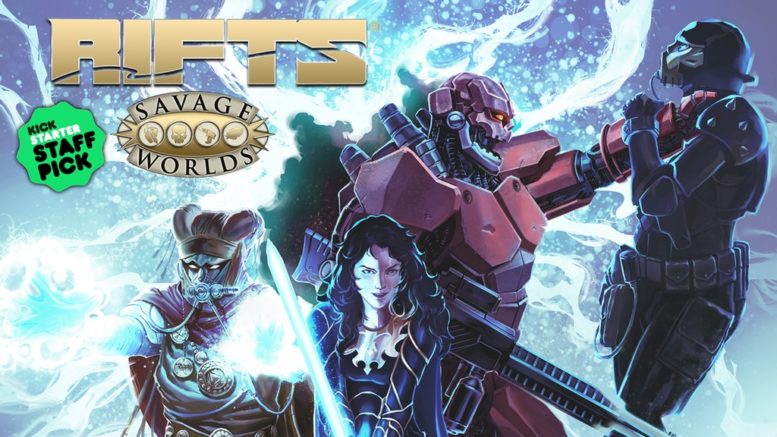If you were playing tabletop role-playing games, back in 1990, along with calling them just ‘role-playing games’ (or ‘RPGs’) you were probably picking up one of a number of gaming magazines on a regular basis. This could range from the immensely general Games Magazine, to the more RPG-focused Dragon Magazine, to the Games Workshop-focused White Dwarf, to any and all options in-between.
And, if you were getting one of these magazines on, at least a somewhat regular basis or, for that matter, reading comic books published by Marvel or DC, then you were privy to a strange series of ads that included images of demons, giant robots, half-naked warrior women, monsters, techno-wizards, and all sorts of strangeness.
This was the advertising frenzy for Palladium Book’s Rifts.
At the time, Palladium was still coasting high off the immensely popular Teenage Mutant Ninja Turtles & Other Strangeness series of RPGs, and the excellent Robotech RPG. The company had produced a host of other games that ranged across genres, including horror (Beyond the Supernatural), post-apocalyptic (After the Bomb), superhero (Heroes Unlimited), military (RECON), sci-fi (The Mechanoid Invasion), espionage/martial arts (Ninjas & Superspies), and, of course, fantasy (the imaginatively named Palladium Fantasy Role-Playing Game). Like many other game companies of the era, Palladium cast a broad net in order to get as many people playing their games as possible. One aspect of their approach that was relatively unusual, however, was that the system used by Palladium was universal, enabling players to have a similar gaming experience whether they were battling dragons with swords and sorcery, fighting the Foot Clan in the sewers of New York, or jumping in their Veritech fighter to push back the Zentraedi menace.
Certainly there were companies with generic systems; hell the ‘G’ in Steve Jackson Games’ GURPS System stood for ‘Generic;’ but few of these had licenses as high-profile as TMNT or Robotech. Most licensed games were, by design, developed to live within their own, unique rules systems. This was done, generally, in order to adequately simulate the source material or to separate a licensed game from an RPG company’s other, in-house properties. West End Games, for example, had the license for both Star Wars and Ghostbusters and produced game systems that were spectacularly divergent from their own in-house games, Paranoia and Torg, as well as one-another.
Palladium’s founder, however, Kevin Siembieda, had entered into the role-playing industry with a goal to build a single system and use that for each game; simply adjusting the level of play to represent the desired effect. His reasons for doing this have long been under question, as he has always stated this was a desire to enable people to jump from game to game with ease, but there was also a financial factor: it is cheaper to produce one set of working rules and repeat these rules from game to game. To those purchasing the gaming books, this means that they feel like they are purchasing pages and pages over and over again but to Palladium, this means reduction on the needs for development for page count.
Regardless of the actual motivation behind this, a side effect was that there were basements across America where mutant animals, superheroes, wizards, and people in powered-armor are battling side by side.
Ever the opportunist, Siembieda analyzed this result and decided to cash in.
To be fair, the way he cashed in is absolutely brilliant.
The initial Rifts Core rulebook introduced readers to Rifts Earth, a world two centuries in the future of our own world, where an apocalyptic event caused portals to other worlds to open up and change the face of the planet. Beings of power from worlds of every conceivable genre; conveniently including all of those I mentioned in games published by Palladium; walked across Rifts Earth. Gods, dragons, vampires, Lovecraftian horrors, and all varieties of beasties suddenly arrived to feast of a relatively helpless humanity. Aliens, dwarves, superhumans, mutant animals, and all sorts of beings found themselves trapped on the Earth, alongside the humans who had slid down the food chain. Atlantis returned, Avalon rose, magic became commonplace.
This was the world of Rifts.
It was every comic book, fantasy novel, science fiction TV show, and horror film wrapped in one insane package. This was the game that Palladium presented and, frankly, it was pretty awesome right from the beginning. With each sourcebook released, some new aspect of this world increased the already massive stakes. Since 1990, over 80 books have been released by Palladium to support the Rifts Megaverse.
As cool as Rifts was, right from the start, the issues with the system were prevalent, as well. Despite having been developed to account for a wide array of genres, it didn’t necessarily handle any of these genres too terribly well. While gamers were exploring more advanced and agile gaming systems and while less advanced systems were being improved upon, Palladium’s system began to look like something from a bygone era. In all the years since, there hasn’t even been minimal improvement to make the system more balanced or accessible.
But the universe of Rifts; the greater Megaverse; is expansive and exciting and has a different feel at every corner.
Over the last few years, the books from Palladium have diminished to a trickle. Thousands of pages of content is available for the Rifts Megaverse, but new material has all but stopped. Part of this can be attributed to the overall reduction in tabletop game sales, but Palladium’s inability to evolve has to have at least some small amount of the blame. Siembeida’s desire to maintain the integrity of Palladium’s intellectual properties has long bordered on paranoia and is legendary in gamer circles. Economically, the company has found itself in an barely sustainable situation.
Enter: Pinnacle Entertainment Group.
One of the many game companies to come out of the mid-1990s, Pinnacle’s first big success came from the immensely imaginative Deadlands: The Weird West, an alternate-history, gonzo Western setting with supernatural and steampunk elements. Deadlands introduced a unique rules system that relied on dice (as most games tend to), playing cards, and poker chips. Since then, the company has produced a wildly diverse series of games and supplements, developing its own generic system in 2003, the Savage Worlds system through which it has released a number of unique gaming concepts.
At some point, someone from Pinnacle and someone from Palladium managed to get in a room and discuss working together. One has to assume that there was a handshake and that handshake, for those of us who still remember and revere Rifts, may alter the very foundation of the gaming industry.
Listen, I will gripe about the limitations on the Palladium system and I have long complained about the exponential increase in power level with the release of each successive sourcebook and I will sneer at the pages of text and art that repeat themselves over and over through multiple books, but make no mistake: I am a Rifts fan.
Last year, in a fit of nostalgia, I started to rebuild my Rifts collection; having had it destroyed by water damage nearly two decades ago. I have a pretty solid dent in replacing my original collection and have managed to pick up a few books that I hadn’t owned prior. While I was going through this, I discovered that Pinnacle and Palladium had entered into a deal and that, at some point in the future, they would be releasing a Kickstarter.
That Kickstarter has come to pass.
Over the last 22 days, the first crowd-sourcing for a Rifts project has drastically exceeded expectations and, in response, Pinnacle has added levels and levels of stretch goals that are exciting for old-school Rifts fans like myself. The products already look like they will be must haves for tabletop enthusiasts with high-quality production and a reverence for those products that came before.
As of this writing, you have 8 days to jump on the Savage Rifts bandwagon. Shane Hensley has done an excellent job curating this project and making it worthwhile for all those that are willing to invest their hard-earned money.
Despite any complaints I’ve ever had for Palladium’s products, Rifts has always been a sandbox that I have enjoyed playing in…
A huge, terrifying sandbox filled with fascist powersuits, dragons, vampires, and would-be gods.
That’s my kind of sandbox.

